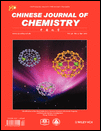Mechanism of Silver(I)-Catalyzed Enantioselective Synthesis of Axially Chiral Allenes Based on Propargylamines
Abstract
The silver(I)-catalyzed synthesis picture of axially chiral allenes based on propargylamines has been outlined using density functional theory (DFT) method for the first time. Our calculations find that, the coordination of silver(I) into triple bond of propargylamines at anti-position of nitrogen shows a stronger activation on the triple bond than that at cis-position, which is favorable for the subsequent hydrogen transfer. The NBO charge analysis for the hydrogen transfer affirms the experimental speculation that this step is a hydride transfer process. The energy barrier of the anti-periplanar elimination of vinyl-silver is 26.9 kJ·mol−1 lower than that of the syn-periplanar elimination, supporting that (−)-allene is the main product of this reaction. In a word, the most possible route for this reaction is that the silver(I) coordinates into the triple bond of propargylamines at anti-position of nitrogen, then the formed silver(I) complex undergoes a hydride transfer to give a vinyl-silver, finally the vinyl-silver goes through an anti-periplanar elimination to give (−)-allene. The hydride transfer with the energy barrier of 44.8 kJ·mol−1 is the rate-limiting step in whole catalytic process. This work provides insight into why this reaction has a very high enantioselectivity.




